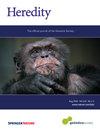Female-mediated selective sperm activation may remodel major histocompatibility complex-based mate choice decisions in humans
IF 3.9
2区 生物学
Q2 ECOLOGY
引用次数: 0
Abstract
Major histocompatibility complex (MHC) genes are known to mediate mate choice both at the individual and gamete level. However, it has remained unclear how different episodes of MHC-associated mate choice interact and contribute to the total selection on MHC genes. Here, we clarified this interaction in humans by performing a full-factorial experiment where 10 females first ranked the attractiveness and intensity of the body odours of 11 males. Then we studied whether female odour preferences in these same 110 male-female combinations predicted sperm performance in the presence of follicular fluid (sperm-stimulating female reproductive fluid). When analyzing the total MHC similarity (including classical and non-classical MHC genes) of the male-female combinations, we found that females preferred the body odours of MHC-similar males, but that sperm motility was positively affected by the MHC dissimilarity of the male-female combinations. No associations were found for classical MHC genes only. Furthermore, odour preferences were negatively associated with sperm motility at the end of the follicular fluid treatment. Together, our results indicate that individual and gamete-level mate choice processes may act in opposing directions and that the most attractive males are not necessarily the most optimal partners at the post-copulatory level. Finally, our findings suggest that gamete-mediated mate choice may have a definitive role in disfavouring genetically incompatible partners from fertilizing oocytes.

女性介导的选择性精子激活可能重塑人类主要的基于组织相容性复合物的配偶选择决策。
已知主要组织相容性复合体(MHC)基因在个体和配子水平上介导配偶选择。然而,目前尚不清楚MHC相关择偶的不同阶段是如何相互作用并对MHC基因的总体选择做出贡献的。在这里,我们通过进行全因子实验来澄清人类的这种相互作用,其中10名女性首先对11名男性的身体气味的吸引力和强度进行排名。然后,我们研究了在这110种男性-女性组合中,女性的气味偏好是否能预测卵泡液(刺激精子的女性生殖液)存在时精子的表现。在分析男女组合的总MHC相似性(包括经典和非经典MHC基因)时,我们发现女性更喜欢MHC相似的男性的体臭,但精子活力受到男女组合MHC差异的积极影响。没有发现仅与经典MHC基因相关。此外,在卵泡液处理结束时,气味偏好与精子活力呈负相关。总之,我们的研究结果表明,个体和配子层面的配偶选择过程可能是相反的,最有吸引力的雄性不一定是交配后最理想的伴侣。最后,我们的研究结果表明,配子介导的配偶选择可能在使基因不相容的伴侣无法使卵母细胞受精方面发挥决定性作用。
本文章由计算机程序翻译,如有差异,请以英文原文为准。
求助全文
约1分钟内获得全文
求助全文
来源期刊

Heredity
生物-进化生物学
CiteScore
7.50
自引率
2.60%
发文量
84
审稿时长
4-8 weeks
期刊介绍:
Heredity is the official journal of the Genetics Society. It covers a broad range of topics within the field of genetics and therefore papers must address conceptual or applied issues of interest to the journal''s wide readership
 求助内容:
求助内容: 应助结果提醒方式:
应助结果提醒方式:


